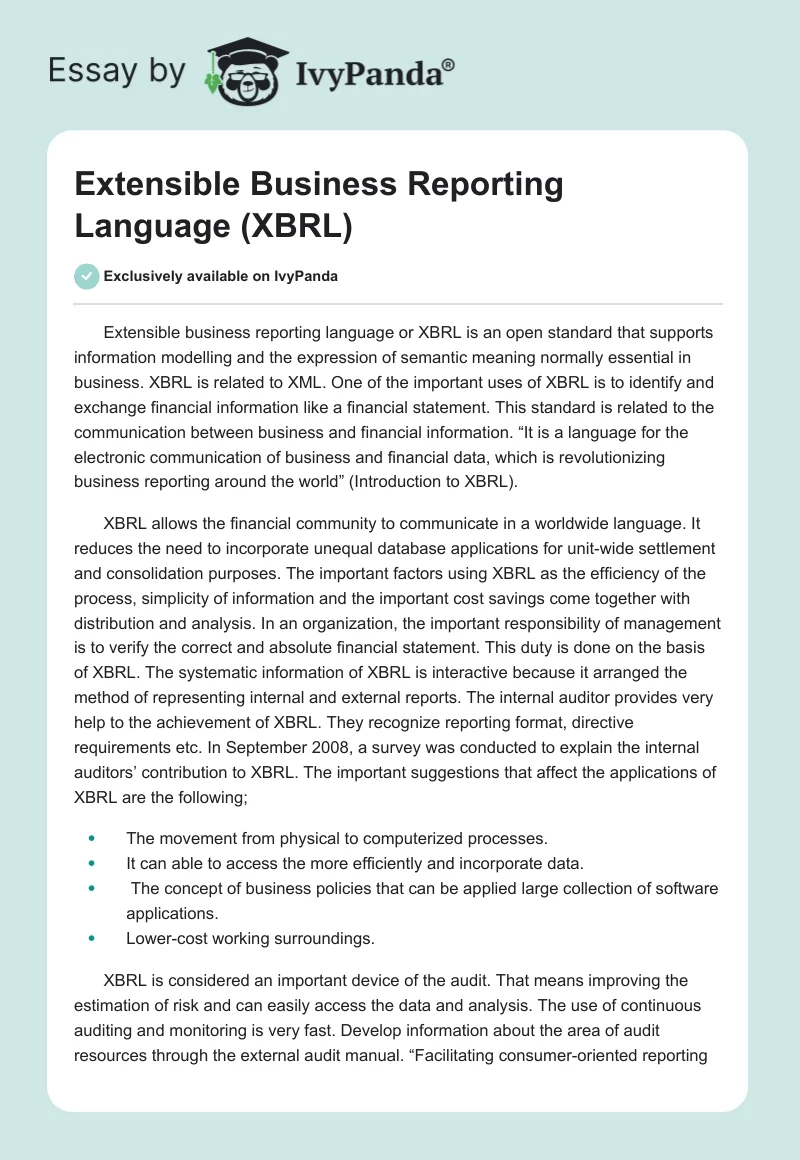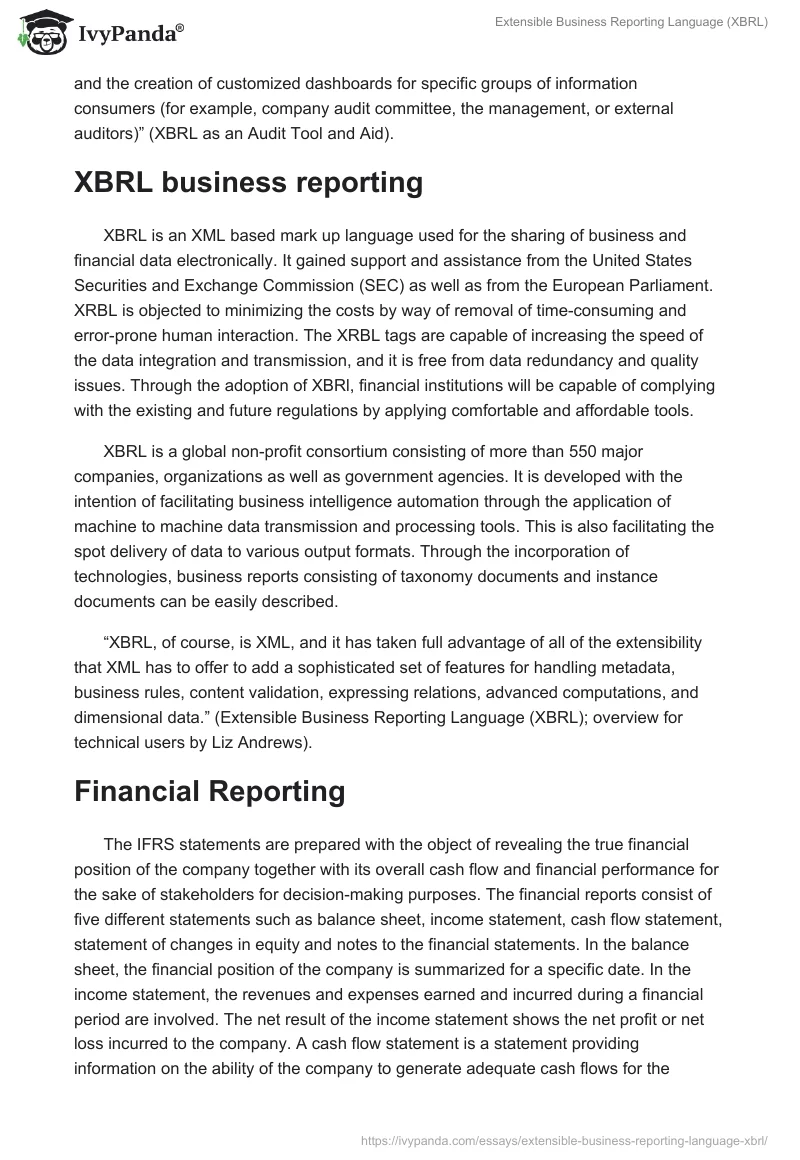Extensible business reporting language or XBRL is an open standard that supports information modelling and the expression of semantic meaning normally essential in business. XBRL is related to XML. One of the important uses of XBRL is to identify and exchange financial information like a financial statement. This standard is related to the communication between business and financial information. “It is a language for the electronic communication of business and financial data, which is revolutionizing business reporting around the world” (Introduction to XBRL).
XBRL allows the financial community to communicate in a worldwide language. It reduces the need to incorporate unequal database applications for unit-wide settlement and consolidation purposes. The important factors using XBRL as the efficiency of the process, simplicity of information and the important cost savings come together with distribution and analysis. In an organization, the important responsibility of management is to verify the correct and absolute financial statement. This duty is done on the basis of XBRL. The systematic information of XBRL is interactive because it arranged the method of representing internal and external reports. The internal auditor provides very help to the achievement of XBRL. They recognize reporting format, directive requirements etc. In September 2008, a survey was conducted to explain the internal auditors’ contribution to XBRL. The important suggestions that affect the applications of XBRL are the following;
- The movement from physical to computerized processes.
- It can able to access the more efficiently and incorporate data.
- The concept of business policies that can be applied large collection of software applications.
- Lower-cost working surroundings.
XBRL is considered an important device of the audit. That means improving the estimation of risk and can easily access the data and analysis. The use of continuous auditing and monitoring is very fast. Develop information about the area of audit resources through the external audit manual. “Facilitating consumer-oriented reporting and the creation of customized dashboards for specific groups of information consumers (for example, company audit committee, the management, or external auditors)” (XBRL as an Audit Tool and Aid).
XBRL business reporting
XBRL is an XML based mark up language used for the sharing of business and financial data electronically. It gained support and assistance from the United States Securities and Exchange Commission (SEC) as well as from the European Parliament. XRBL is objected to minimizing the costs by way of removal of time-consuming and error-prone human interaction. The XRBL tags are capable of increasing the speed of the data integration and transmission, and it is free from data redundancy and quality issues. Through the adoption of XBRl, financial institutions will be capable of complying with the existing and future regulations by applying comfortable and affordable tools.
XBRL is a global non-profit consortium consisting of more than 550 major companies, organizations as well as government agencies. It is developed with the intention of facilitating business intelligence automation through the application of machine to machine data transmission and processing tools. This is also facilitating the spot delivery of data to various output formats. Through the incorporation of technologies, business reports consisting of taxonomy documents and instance documents can be easily described.
“XBRL, of course, is XML, and it has taken full advantage of all of the extensibility that XML has to offer to add a sophisticated set of features for handling metadata, business rules, content validation, expressing relations, advanced computations, and dimensional data.” (Extensible Business Reporting Language (XBRL); overview for technical users by Liz Andrews).
Financial Reporting
The IFRS statements are prepared with the object of revealing the true financial position of the company together with its overall cash flow and financial performance for the sake of stakeholders for decision-making purposes. The financial reports consist of five different statements such as balance sheet, income statement, cash flow statement, statement of changes in equity and notes to the financial statements. In the balance sheet, the financial position of the company is summarized for a specific date. In the income statement, the revenues and expenses earned and incurred during a financial period are involved. The net result of the income statement shows the net profit or net loss incurred to the company. A cash flow statement is a statement providing information on the ability of the company to generate adequate cash flows for the business operations. Statement of changes in equity explains the changes in the shareholders equity at the end of a financial year. Notes to the financial statements is an additional statement of information prepared with the intention to explain specific items in the financial statements. The statement of internal accounting policies of the organization is also included in this.
Differentiated from traditional methods of financial statements presentation, XBRL is aimed to verify the data on an automation mechanism basis. It adopted advanced data exchange integration and analysis technologies for the reporting, and thus, credibility and transparency can be ensured at a higher level. With the XBRL taxonomies, the individual financial disclosure requirements of companies can be effectively fulfilled. Through this, organizations can prepare financial statements on a more accurate and reliable basis without losing data integrity. It consists of two distinct parts as concepts and relationships. In the concepts part, the XML technologies adopted for the resulting document is explained. In the relationships part, the relationship between concepts and other resources is explained.
Semantic expression is another advantage of the XBRL. It has the ability to express semantic meanings through using extended links. Multidimensional data representation is possible through this tool. Normalization is another advantage of the XBRL tool. By way of applying standard data format for the electronic transmission of data, it creates industry standards. It facilitates the verification of the calculations and other relationship in the financial statements through the normalization process.
“XBRL allows software vendors, programmers, intermediaries in the preparation and distribution process and end-users who adopt it as a specification to enhance the creation, exchange, and comparison of business reporting information.”(Abstract; Extensible Business Reporting Language (XBRL) 2.1 RECOMMENDATION – Corrected Errata – 2005).
The XBRL Financial Statement Repository facilitates the storage of the five financial statements prepared through the XBRL tool and placing them on the websites for access to the stakeholders. “The XBRL ‘Financial Statement Repository’ stores five financial statements which have been prepared using XBRL and placed on the website to provide test data. For example, if you wanted to prepare extraction and comparison prototypes to test the XBRL concept, you could use this data.”
As an electronic format, XBRL is facilitating the presentation of financial statements, consisting of performance reports, accounting records, and other financial information in a simplified manner by applying for software programs. It is free from royalty payments as it is an open consortium developed collaboratively with the intention to reduce the cost of publishing financial information as well as presentation in a more understandable manner. Quickly and easily transferring financial information is made possible through this tool. The duplication of financial data is avoided through this tool, and thus, errors and inconsistencies are effectively prevented.
“XBRL enhances the usability and transparency of financial information reported under existing accounting standards, simplifies disclosure, and allows companies to communicate financial information more readily via the Internet.” (What is XBRL? An introduction to XBRL).
XBRL –tagged data makes the data searching process quicker an
The benefits of XBRL:
- Accountants get adequate and reliable data on the financial performance of the company with reduced efforts and time. It reduces the cost of collection and analysis of the data. The software applications improve efficiency.
- The creditors of the company can obtain reliable information on repaying capacity of the company at a faster rate, and thus, quick decision-making is possible.
- Companies are able to automate their data collection, and thus errors can be identified and corrected on a real-time basis.
The PDF-based financial reports presentation are subjected to inflexibility. The users face difficulty with locating and extracting required data from these statements. XBRL is free from these limitations, and through, this a common taxonomy can be adopted by the company.
The minimal general and systems control that Great Lakes have to be adopted for supporting the implementation of XBRL:
The implementation of XBRL on financial reporting has potential impacts on data quality. They are discussed below.
Intrinsic data quality: The intrinsic data quality of XBRL is limited in nature. The verification of the accuracy of the input data through XBRL is subjected to limitations. It is not capable of identifying the malpractices of the accountants on the assets and revenue value.
Accessibility data quality: Even though XBRL facilitates easy Accessibility of the information in the financial reports, its security cannot be ensured at the appropriate level.
Contextual data quality: The Schema and presentation link bases applied on the XBRL ensures the contextual data quality, and thus, complete and relevant information can be ensured.
Representational data quality: Through standard browser technology, concise and consistent information can be accessed by the stakeholders.
Before the implementation of the XBRL in the organization, the return on investment from the project, its relevant costs and its long-term benefits has to be identified and analyzed. The proper conversion process also has to be identified. Proper training should be provided to the employees for the effective conversion process to XBRL.
The Great Lakes Inc. has to take adequate control measures for eliminating the limitations of the XBRL language on the data quality for supporting its effective implementation.
References
Extensible Business Reporting Language (XBRL); overview for technical users by Liz Andrews Web.
Abstract; Extensible Business Reporting Language (XBRL) 2.1 RECOMMENDATION – Corrected Errata – 2005. Web.
Extensible Business reporting language Web.
What is XBRL? An introduction to XBRL.


